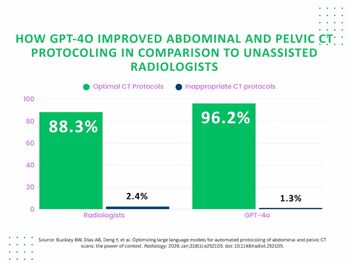
Thin CT slices aid visualization of artery injured in blunt pelvic trauma
Thin CT slices are better than thick ones at identifying obturator arteries in blunt pelvic trauma patients, according to a study from Loma Linda University.
Thin CT slices are better than thick ones at identifying obturator arteries in blunt pelvic trauma patients, according to a study from Loma Linda University.
Pelvic trauma accounts for 6% to 8% of all trauma deaths, and the variant obturator artery, also known as the corona mortis, is a common site of bleeding. If an interventional radiologist becomes familiar with the typical sites of pelvic bleeding, he or she can quickly determine if a patient needs embolization.
In a study involving 50 consecutive blunt trauma patients, Dr. Jason C. Smith, an interventional radiologist at Loma Linda University, and colleagues examined 29 corona morti in 100 hemipelves (JVIR 2009;20;455-460). Standard protocol calls for contiguous 5-mm-thick axial images, but only 10 corona morti were identified using 5-mm slice thickness. Using 1.25-mm coronal images, the examiners identified 25 of the corona morti, while all 29 were identified using 1.25-mm axial images.
Half of the patients were imaged using a 16-slice scanner, and the other half with a 64-slice scanner. The reviewers all agreed that the 64-slice images were easier to read than the 16-slice images, especially in challenging cases such as patients with suboptimally enhanced or diminutive caliber corona morti and those with regional distortions.
"It is important that both diagnostic and interventional radiologists be familiar with the typical sites of pelvic bleeding from trauma, as well as the potential anatomic variations of the origins and courses of bleeding arteries," Smith said.
CT examination can prospectively identify the bleeding arterial culprit, he said.
The study suggests the potential ability to identify the corona mortis on contrast-enhanced multislice CT in pelvic trauma patients and to guide the interventionalist in subsequent endovascular embolization, Smith said.
This study should help clinicians with their decision making, according to Dr. Spyros Darmanis, an orthopedic surgeon at St. George's Hospital in London.
"This study will affect radiological practice, because it will force the radiologist to look more carefully at the pelvis and not to underestimate minor vessels that can prove lethal," he said.
While the study is well documented and well presented, it has some limitations.
"Most coronas are of venous origin, and, as far as I am concerned, endovascular embolization in this setting is of limited use," Darmanis said.
Other limitations of the study include the prevalence of nontraumatic and relatively young patients.
Newsletter
Stay at the forefront of radiology with the Diagnostic Imaging newsletter, delivering the latest news, clinical insights, and imaging advancements for today’s radiologists.




























